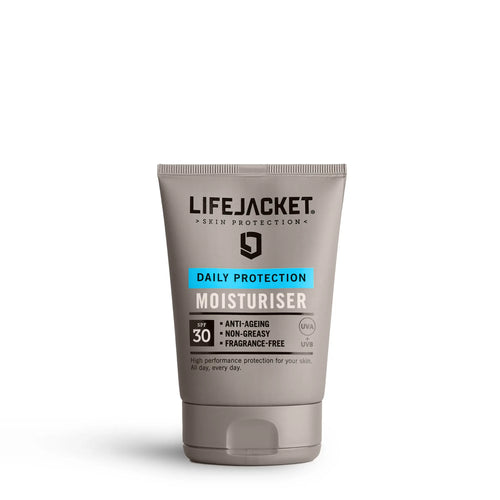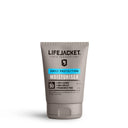Without wanting to make things too technical in this week's post, we thought it might be useful to describe the process by which sunscreens get their SPF and UVA ratings, so you can be reassured they're safely protecting your skin. We'll also explain how the less measurable and more 'marketing' type claims make it onto the labels of your favourite bathroom products.
The LifeJacket way
'High performance' is the most important criterion that all LifeJacket products anchor themselves to.
For us, that means several things, including: product safety, efficiency and usability but, above all, it means thorough and robust testing. We refuse to compromise on any of these things and hopefully, you've experienced that for yourself while using our stuff.
But to reassure you that the testing is thorough and robust, this is what we go through before putting anything into the marketplace and onto your skin.
SPF testing
Sun Protection Factor (SPF) measures how much a product protects you from UVB light. This is the wavelength of light that burns the skin. The fancy term for this is 'erythema'. UVB light causes an 'erythemal response' on your skin, which becomes important later.
The SPF of a product tells you how long a product protects you from UVB light assuming you apply it correctly. Without any sunscreen, your skin would show signs of burning in approximately 5-10 minutes, depending on your skin type. The theory is that you take that figure and multiply it by the SPF. So, SPF 30 protects you for 10 x 30 = 300 minutes. You can read more about SPF here.
Because UVB light has a clear and obvious reaction on your skin, it's possible to test a product by directing UVB light onto human skin and seeing when the skin gets an erythemal response. This is a standard ISO (International Organisation for Standardisation) protocol for testing all sunscreens.
How does it work?
Between 10 (minimum) and 25 (maximum) healthy volunteers, representing a range of skin tones, have UV radiation lamps pointed at the skin on their backs
The exposed area is divided into three - one area that's applied with the sunscreen being tested, one that's applied with a sunscreen with a known and tested SPF and a final one that's completely untreated i.e. the control
The amount of sunscreen put on the skin is standardised and this is where the 5ml per body part recommendation that you always see comes from - it's because the SPF is measured assuming you use at least this amount
UVB light is then pointed at the sunscreen covered skin and if that doesn't produce a response, the UVB dose is upped. The dose is increased until the skin's response matches the control. The lab testers work their way up in terms of dose. The higher the dose, the higher the SPF
The volunteers' skin response is checked after 16-24 hours by a qualified assessor who is looking for redness, known as the Minimal Erythema Dose (MED). This is where the process has been subject to challenge because an assessor's view might be subjective or inconsistent
The ethics of exposing humans to UVB light have been questioned but so far, no laboratory alternative has been approved or accepted.
UVA testing
This one is much simpler but no less important.
Unlike SPF testing, UVA isn't tested on human volunteers. Partly because UVA light penetrates deeper into the skin (which might be more dangerous) but also because there is a limited immediate or visible effect of UVA exposure.
Instead, a laboratory spectrophotometer (a light-measuring machine) is used to measure the amount of UVA radiation absorbed by our sunscreen on a petri dish. Certain thresholds must be met from this measurement to achieve the various international UVA protocols.
This is known as in vitro because the experiment takes place on a petri dish in a laboratory rather than in vivo i.e. on a living human.
Safety testing in pack
Testing the 'vessel' that a sunscreen is stored inside is critical to ensure its ingredients and protective properties don't change for any reason. Ultimately, the tests here are checking that the quality of the cosmetic product remains unchanged and that no problems or reactions take place as a result of the packaging material.
For example, if the sunscreen is stored inside a clear glass bottle, would the sunscreen still work if that bottle sat in the sun all day or if it froze?
Known as compatibility testing, we use a laboratory to create accelerated storage conditions. Over a period of three months, we run regular tests on the formulation to ensure it holds together when subjected to high temperature, low temperature and freeze/thaw.
At every stage, we look for any changes to the sunscreen. If there are any whatsoever, it fails and we start the reformulation process all over again.
Other packaging claims
When we design a skincare product, we start by thinking of the things that are important to us in terms of how we want the product to look or feel. Often, these things aren't precisely measurable.
For example, we knew that if we were going to achieve our mission and persuade people to change their daily behaviour by using an SPF moisturiser every single day, our Daily Protection Moisturiser needed to be lightweight and non-greasy.
But how do you measure something so subjective so you can write it on your packaging and use it as a marketing claim?
The answer is through panel testing. This is exactly what it sounds like. You ask a panel of people to use the product for a period of time and then pose a series of questions that tease out if their experience matched the claim you want to make. If the result of the panel test supports our product claim in a statistically robust manner, we're entitled to put 'lightweight' on our packaging. Which it did, et voilà!
Costly but critical
Because of the challenges involved in making sunscreen, from the expensive and technical ingredients to the extensive testing required, you can quickly see why sunscreens cost more than basic bathroom products.
But there can't be any compromise on the protection offered by sunscreens given the damage solar UV light can cause. Sunscreen is literally a lifejacket. And given our name, we take this all incredibly seriously.






